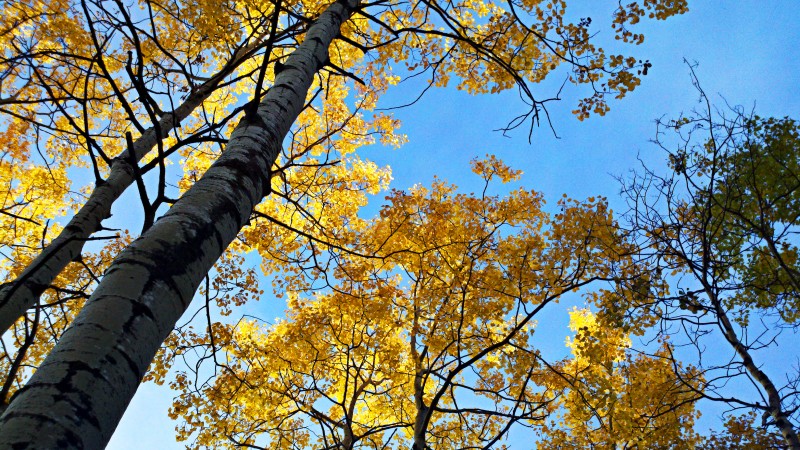
Poplars, October, Fort McMurray, Alberta
THEME: We write articles about our pictures, endlessly describing lenses, techniques, and lighting conditions, but sometimes forget to learn about the subjects themselves. Study your subject, and your subject’s story may be the richest part of your image. Otherwise, it’s just another pretty picture. I discovered this when I learned about what I thought was a pretty dull piece of forest.
Compared to my coastal homeland, with its drama of mountains, enormous Western cedars, plunging waterfalls,and miles of ever-changing beaches, Alberta’s northern boreal forest seemed uninteresting. Miles upon miles of rolling trackless wilderness, with the occasional hill, creek, or gently moving river. Much of it, flat and boggy muskeg swarming with mosquitoes in summer, is impossible to explore. In between ridges of black spruce, tamarack and poplar, fields of waving grass and reeds conceal four inches of water over six inches of boggy sphagnum moss. Underneath all lies two inches of muck waiting to entrap the incautious boot. Yet having lived in the boreal woods through three seasons, I am beginning to see it as a land of subtle beauty and decorous changes from place to place, with a marsh here, a meadow there, and patches of poplar alternating with forests of spruce, tamarack and larch.
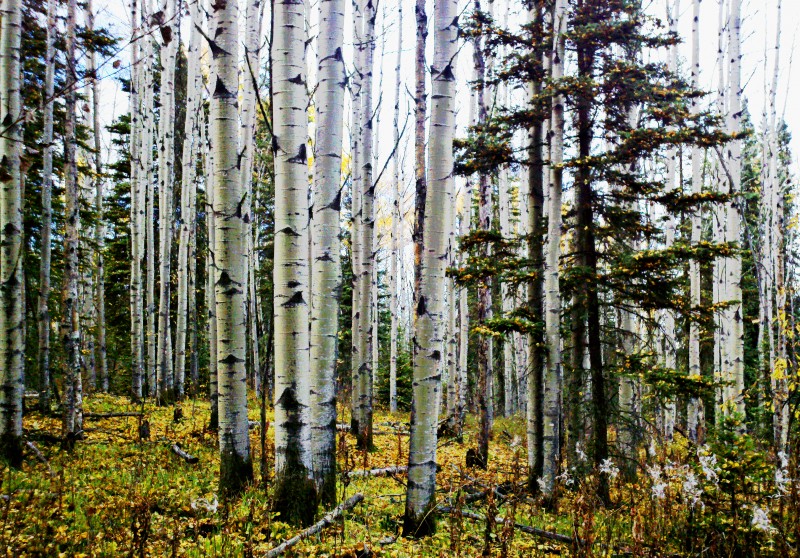
Boreal Forest Poplar Glade
The northern boreal forest, or taiga, constitutes the earth’s large land ecosystem, consisting of a broad band of mixed forest surrounding the globe in the high northern latitudes, and encompassing much of Canada, Russia, Sweden, Finland, and Norway. Plant species vary, but in northern Alberta, this forest includes primarily black spruce, tamarack, and larch, with patches of poplar and birch. Despite low annual precipitation (8-30 inches/year), cool temperatures and abundant fog limit sunshine, minimizing evaporation and supporting a damp and boggy environment. Much of European and North American taiga was recently glaciated; receding glaciers have left depressions in the

Muskeg with Marsh and Ponds
topography that have filled with water, creating vast areas of lake and bog throughout the taiga. As a consequence of the recent glaciation, these forests are young and biodiversity is low, with limited number of species in each plant family. Soils are heavily leached, nutrient-poor, and acidic, favoring the growth of mosses and lichen on the forest floor. Wide temperature variations are the norm, with long, cold winters and short, warm summers.
Travelling the highways and muddy service roads around Fort McMurray, I struggled to capture the spirit of this land. Many pictures of low hills, sunset lakes and megamachinery left me unsatisfied. Fort McMurray was dusty and uninspiring. My vintage cameras languished in the closet, and I snapped pictures with my Droid and little point-and-shoot, not wanting to waste film.
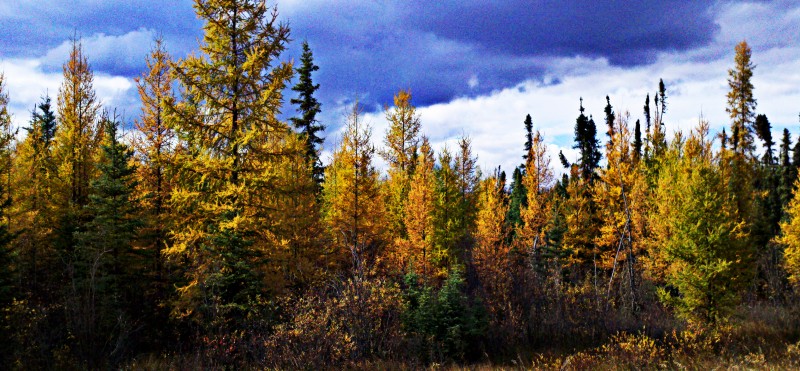
Larch Grove
All changed when fall arrived, and the dowdy forest donned her party dress and went dancing on the October wind. Suddenly, poplars painted the hills with broad swathes of brilliant yellow and gold. Late afternoons became luminous as the setting sun turned glades of poplar to flame-topped candles poised above the darkening forest floor. Only slightly less brilliant, larch groves, hidden coyly among the spruce, flared into golden prominence.
As October progressed, the magnificence of the treetops slowly dimmed, and I sadly took my last pictures of the sunlit poplar – only to see the forest floor come to life as it became the humble forest carpet’s chance to party. As the cascade of color slowly fell from the treetops, the dull carpet of leaves became a kaleidoscopic array contrasting with the clean gray of fallen logs and complementing the color palette of the low-growing forest

Bunchberry, Linnaeus, and Moss
plants. The oranges and reds of fall bunchberry blazed against the greens of moss and twin-flower (Linnaea borealis). The greys of lichen became an important part of the color
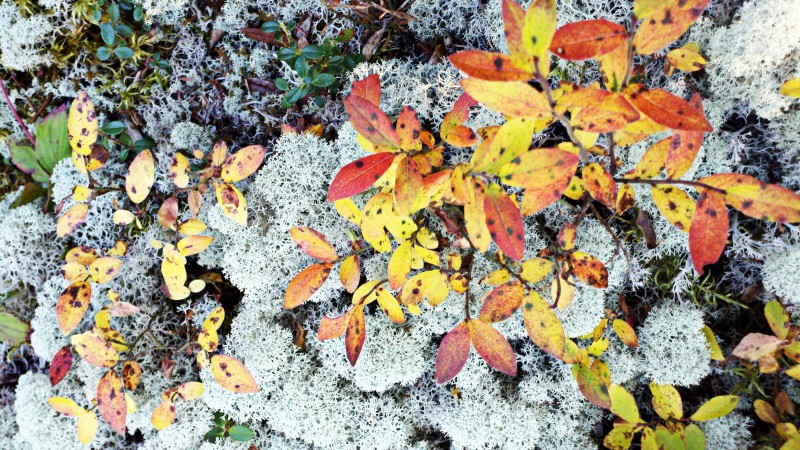
Alpine (Bog) Blueberry and Lichen, Engstrom lake, Alberta.
palette, highlighting the orange splashes of alpine blueberry.
Browsing even a limited part of this forest floor, it was difficult to find a bad picture. Moving close to the ground brought into focus the curved, serrated edges of two leaves sitting
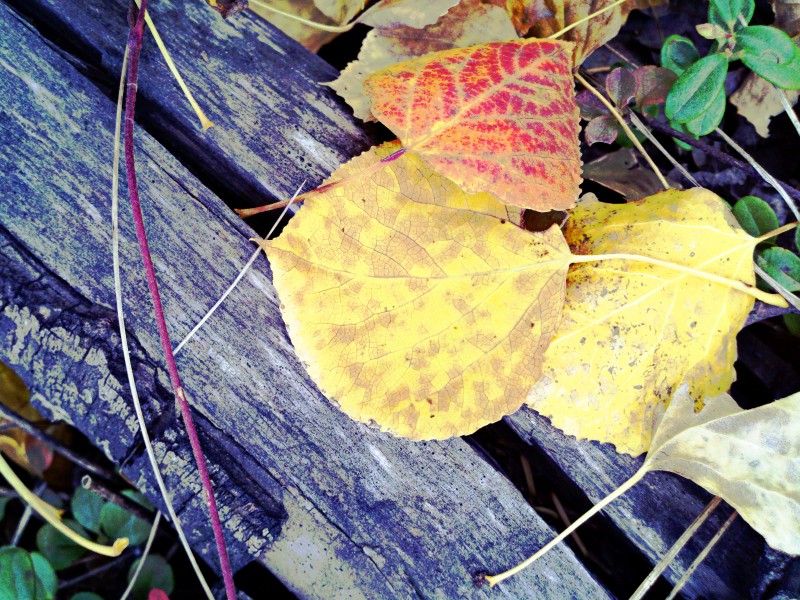
Two Leaves
atop the lines of a cracked grey poplar log. Moving away to examine the broader scene revealed the mottled silver of a birch trunk lying beneath a carpet of multicolored leaves.
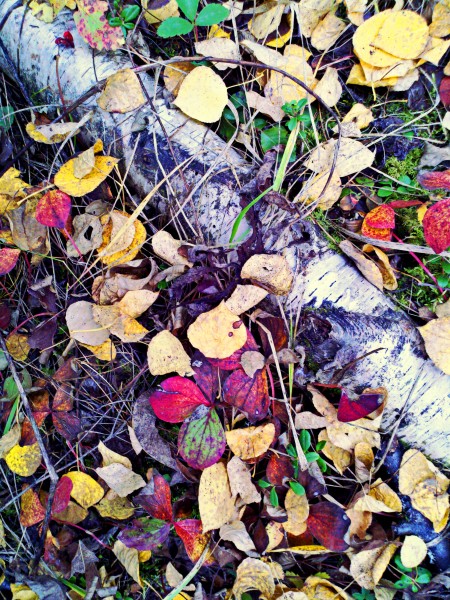
Fallen Birch and Leaves
The most wondrous part of the boreal forest, however, lies invisible beneath the forest floor. Mushrooms and other fungi form a prominent part of the forest community, and are frequently seen poking up between the leaves and jutting out of decaying logs and stumps.
Yet mushrooms are only the surface manifestation of an enormous, complex organism living in symbiosis with, and essential to the survival of, each spruce, larch, or poplar. Each tiny root hair intertwines with complex meshwork of fungal filaments giving the tree
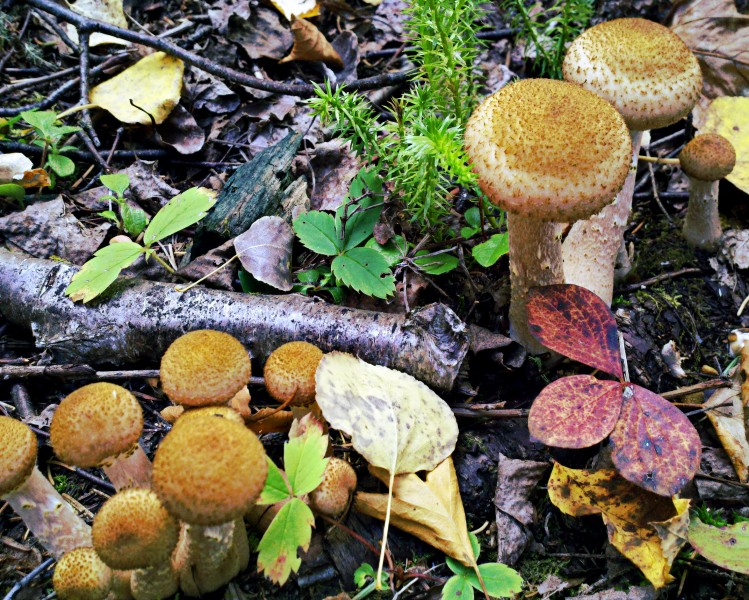
Mushrooms and Moss
enhanced access to water and nutrients: “… fungal filaments or hyphae have an intimate association with the outside of small roots of trees and greatly assist water and nutrient uptake into the roots of these host plants. ….the fungal hyphae surround the root tips and
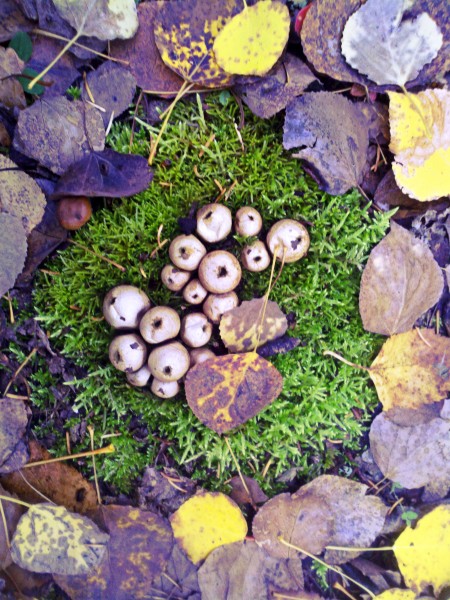
Puffballs and Leaves
invade between cells inside roots. These mycorrhizal hyphae are much finer than the root hairs, and greatly increase the surface area available for absorption of nutrients and water from the nutrient-poor soil. In addition, the glove-like covering of mycelium provides

Shelf Fungus on Stump, Fort McMurray Area
physical protection for the delicate root tips and also a barrier to the entry of soil microorganisms. In return, tree roots …. supply essential carbohydrates and amino acids … necessary for growth of the fungal mycelium and production of fungal fruiting bodies, the mushrooms…” (see “The Boreal Forest Ecosystem“).
So the next time you take a pretty picture of a sunset lighthouse, think about the lives of the lightkeepers and their families. Do some research. Did the keeper save a sailor in the storm of 1885? Did his daughter grow up the only child on a remote island, the wind and the gulls for her playmates? You may find that the glow from the clouds is not just from the evening sun, but from the story that your picture tells you.
Note: All images for this article are digital or Droid X cell phone images, as the few vintage camera photographs I was able to take in Fort McMurray are not yet developed.
References:
Cripps, C. C. “Mycorrhiza.” PNW Plant Disease Management Handbook. http://pnwhandbooks.org/plantdisease/node/1805/print
Riesco, I. L. “Root Seeks Fungus For Long-Term Relationship.” Taiga Rescue network. http://www.taigarescue.org/index.php?view=taiga_news&tn_ID=1103.
University of Alaska, Fairbanks (Fungal Metagenomics Program). “The Boreal Forest Ecosystem.” http://www.borealfungi.uaf.edu/education.html.
University of Wisconsin, Madison. “Boreal Forests, Alpine, and Tundra Biomes.” Online course notes, Department of Botany. http://www.botany.wisc.edu/courses/botany_422/Lecture/Lect13BorForTundra.html.
Wikipedia article, “Boreal Forest of Canada.” http://en.wikipedia.org/wiki/Boreal_forest_of_Canada.
Wikipedia article, “Taiga.” http://en.wikipedia.org/wiki/Taiga.